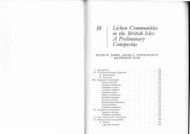You also want an ePaper? Increase the reach of your titles
YUMPU automatically turns print PDFs into web optimized ePapers that Google loves.
places, very thin, KC+/C+ (transient) red-orange<br />
or rarely KC-/C-; sorediate places orange to<br />
reddish, in the herbarium gray-white to<br />
yellowish, UV+ light yellow to white.<br />
Gyrophoric acid or Schizopeltic acid or both<br />
Opegrapha gyrocarpa<br />
21* Thallus cocoa-brown, brown, dark brown, with<br />
smooth, almost velvety upper surface, in the<br />
interior sorediate, ochre-yellowish, rarely<br />
brownish, in the herbarium usually yellowbrown,<br />
or yellowish, usually thick, KC-/C-,<br />
sorediate places/medulla UV+ blue-white.<br />
Schizopeltic acid Lecanactis umbrina<br />
22 Thallus upper surface entirely leprose, i.e. mealy<br />
or covered with fine granules, whitish, light gray,<br />
pale greenish, slightly yellow tinted, or bluishwhite<br />
. GS Lepraria<br />
22* Thallus upper surface not entirely leprose. .. . 23<br />
23 Thallus K+ red 24<br />
23* Thallus K+ yellow to K- 25<br />
24 Thallus whitish to light gray, with irregular<br />
whitish soralia, thin Phlyctis argena<br />
24* Thallus gray, olive-gray, or olive, fissured to<br />
areolate, with bordered soralia .<br />
↑ Aspicilia and Pertusaria excludens<br />
25 Soralia convex, very large, white, KC+ violet.<br />
Thallus gray Pertusaria amara<br />
25* Soralia KC- or KC+ yellow, orange to red . 26<br />
26 Thallus or soralia C+ red or C+ (at least KC+)<br />
(yellow)orange . . 27<br />
26* Thallus or soralia C- to C+ yellowish 36<br />
27 Thallus C+ yellow-orange to orange 28<br />
27* Thallus or soralia C+ red . . 30<br />
28 Thallus P+ orange-red, K+ (weak) yellowish,<br />
strongly developed, usually extensive, fissured to<br />
warty, gray- or greenish-yellow, or greenish gray,<br />
with irregular, partially coalescing, lighter<br />
soralia. Soredia over 35-90 µm. Thiophanic<br />
acid, Stictic acid Pertusaria flavicans<br />
28* Thallus P+ yellow(ish), K+ yellow 29<br />
29 Thallus whitish to gray-white, usually rosetted to<br />
rounded, areolate, C+ yellow-orange, UV+<br />
yellow. Areoles convex, sometimes with<br />
enlarged marginal areoles, <strong>of</strong>ten on a whitish<br />
prothallus. Soralia rounded, whitish(gray).<br />
Sordidon, Rocellic acid, Atranorin<br />
. Lecanora lojkaeana<br />
29* Thallus gray, greenish-gray, thin, without<br />
enlarged marginal areoles, C+ orange, UV+<br />
orange. Soralia pale yellowish to almost whitish.<br />
Atranorin, Arthothelin, Thuringion .<br />
Lecidella scabra<br />
30 Thallus gray-rose to light (gray)brown, <strong>of</strong> convex<br />
areoles, with dark red-brown, warty cephalodia<br />
between them. Soralia whitish to brownish. In<br />
montaine to alpine places .<br />
Amygdalaria panaeola<br />
30* Thallus without cephalodia . 31<br />
31 Soralia P+ yellow, C+ (fleeting) red, K+ yellow.<br />
Thallus gray-brownish to brown, <strong>of</strong> rounded,<br />
scattered to coalescing areoles, on a black<br />
prothallus. Alectorialic acid .<br />
Fuscidea praeruptorum<br />
31* Soralia P- to P+ indefinite yellowish. Gyrophoric<br />
or lecanoric acid 32<br />
32 Thallus with whitish, defined soralia on<br />
isidia-like, peg-form to hemispherical<br />
outgrowths, soralia likewise standing on<br />
outgrowths, -0.5 mm. Thallus areolate, areoles<br />
convex, rarely flat, coalescing or ± separated,<br />
upon a black prothallus, (cocoa)brown, rosebrown,<br />
gray-brown, or yellow-brown, C+ red<br />
(Gyrophoric-acid). Isidia-like outgrowths 0.15-<br />
0.25 mm wide, -0.5 mm high<br />
Rimularia gibbosa<br />
32* Thallus without isidia-like outgrowths . 33<br />
33 Thallus warty-areolate, areoles on a black<br />
prothallus, with green-whitish (to<br />
yellow-whitish), -0.5 mm wide fleck soralia, gray<br />
to greenish-gray, K+ yellow, soralia C+ red.<br />
Atranorin, Gyrophoric acid. Rinodina aspersa<br />
33* Thallus without black prothallus 34<br />
34 Thallus greenish-gray to gray, warty to coarse<br />
granular, with at first delimited, later coalescing,<br />
dirty gray-green to dusty blue-green soralia.<br />
Gyrophoric acid GS Trapelia<br />
34* Soralia whitish to pale green-whitish or beige. 35<br />
35 Thallus thin to moderately thick, whitish to beige,<br />
even sometimes with slightly rose tinted, usually<br />
relatively small, fissured to fissured areolate, is<br />
places erupting sorediate, K-, P-. Above all on<br />
rock, or shaded rocks. Gyrophoric acid<br />
GS Trapelia<br />
35* Thallus usually moderately to very thick, whitish<br />
to light gray, unevenly fissured to fissured<br />
(fissured areolate), extensive. Prothallus<br />
sometimes occurring, whitish. Soralia flat or<br />
convex. Lecanoric or Gyrophoric acid .<br />
GS Pertusaria<br />
36 Thallus at least in places rust colored ochre to<br />
red-brown or almost red. GS Lecidea<br />
36* Thallus not rust colored 37<br />
37 Soralia blackish to dark gray 38<br />
37* Soralia lighter . 39<br />
38 In the mountains on light and wind exposed<br />
places. Thallus fissured areolate to (warty)<br />
areolate, soralia blackish. Medulla I-, P-/P+<br />
yellow. Miriquidic acid, ± Psoromic acid .<br />
Miriquidica nigroleprosa<br />
38* On more sheltered, <strong>of</strong>ten shaded places also on<br />
lower sites. Thallus fissured, soralia gray.<br />
Medulla K+ blue. Medulla/soralia P-.<br />
Confluentic acid. (If Stictic acid, P+ yellow,<br />
medulla I-: P. soredizodes) . .<br />
Porpidia tuberculosa<br />
39 Thallus or soralia P+ red to orange. Thallus<br />
coherent, white to light gray. . . 40<br />
39* Thallus and soralia P- to P+ yellowish 41<br />
40 Soralia small, -0.5 mm rounded. Thallus <strong>of</strong>ten<br />
very small, very thin. Stictic acid<br />
59





